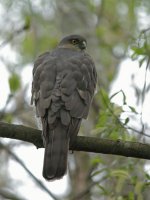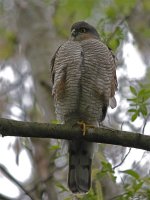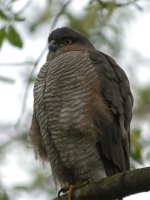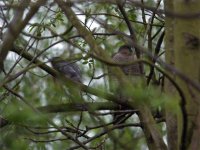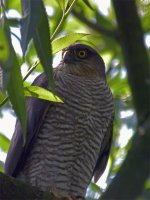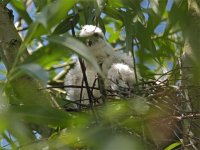-
Welcome to BirdForum, the internet's largest birding community with thousands of members from all over the world. The forums are dedicated to wild birds, birding, binoculars and equipment and all that goes with it.
Please register for an account to take part in the discussions in the forum, post your pictures in the gallery and more.
You are using an out of date browser. It may not display this or other websites correctly.
You should upgrade or use an alternative browser.
You should upgrade or use an alternative browser.
Eurasian Sparrowhawk, Uk (1 Viewer)
- Thread starter rockfowl
- Start date
More options
Who Replied?Jon Turner
Well-known member
Ageing Sparrowhawks in the hand (tricky stuff!!) can be done on the amount of orange in the eye. The more yellow, the more adult, I think. I can't see any orange, so would agree with Macs - an adult male.
Jon
Jon
apbarr
Well-known member

other way round jon,orange indicator of older birds,more so in males,same for goshawk.dai.
beat me to it, eyes turn more orange with age
rockfowl
Mark Andrews
other way round jon,orange indicator of older birds,more so in males,same for goshawk.shot in the dark here-looks like a male-but-is that a brood patch? dai...
Interesting comment Dai!
Here's my confusion. The posted bird was taken this morning in a very small copse where it's been present for some time now. There is a nest and although I've seen this bird on the nest, it spends most of the time sitting around watching the nest from lower branches, I don't believe there are eggs. It appears to be paired, the behaviour of the partner coming in and out indicates this and both birds have been observed removing/defending against any problems. The following image isn't very good but it quite clearly shows a smaller adult male, a quite old, dainty, red-breasted marvel which has avoided the camera very well so far, this is the partner!
He looks small (the bird on the left) though there is some size illusion here, he's a bit larger than he appears here, angle and digital I guess but not the usual size difference perhaps expected. The subject bird is also, I would say average size, perhaps no bigger than a large male. Can a female show such predominantly male characters or do I have a misfit?
No offence to all who thought It an adult male, I did/do too?
Thanks for the positive comments!
Mark
Attachments
Hi Mark,
Take a look at this: http://www.ibercajalav.net/img/118_SparrowhawkAnisus.pdf
Take a look at this: http://www.ibercajalav.net/img/118_SparrowhawkAnisus.pdf
Last edited:
AStevenson
Well-known member
Interesting bird Mark, I've never seen a female that looks so similar to a male. Both Ian Newton in his sparrowhawk momograph and Dick Forsman in his Euro raptors make reference to the the fact that the plumages can be very similar between sexes, but point to the stronger super (!) in the female and the more prominent nape patch being useful characters for separation.
When I used to monitor sparrowhawks more closely I thought there was a bit of a difference in undertail pattern - males have narrower more tapering towards the tail centre bars, females have broader even bars. If that holds generally then your bird again comes out more like a male.
Maybe you've got the only gays in the village?
Cheers,
Andrew
When I used to monitor sparrowhawks more closely I thought there was a bit of a difference in undertail pattern - males have narrower more tapering towards the tail centre bars, females have broader even bars. If that holds generally then your bird again comes out more like a male.
Maybe you've got the only gays in the village?
Cheers,
Andrew
rockfowl
Mark Andrews
Interesting bird Mark, I've never seen a female that looks so similar to a male. Both Ian Newton in his sparrowhawk momograph and Dick Forsman in his Euro raptors make reference to the the fact that the plumages can be very similar between sexes, but point to the stronger super (!) in the female and the more prominent nape patch being useful characters for separation.
When I used to monitor sparrowhawks more closely I thought there was a bit of a difference in undertail pattern - males have narrower more tapering towards the tail centre bars, females have broader even bars. If that holds generally then your bird again comes out more like a male.
Maybe you've got the only gays in the village?
Cheers,
Andrew
That's what I'm thinking! :smoke:
Sexing Sparrowhawks is not always easy, some females can be quite bright. The subject bird has quite reddish cheeks and lacks a clear supercilium, but the back is a bit dull.
Regarding the age, it is at least a 3cy bird. It seems to have an old, unmoulted covert on each wing, wich don't look like juvenal feathers, as they are not too brown or worn. This would perhaps indicate a bird older than 3cy, but I'm not sure.
Regarding the age, it is at least a 3cy bird. It seems to have an old, unmoulted covert on each wing, wich don't look like juvenal feathers, as they are not too brown or worn. This would perhaps indicate a bird older than 3cy, but I'm not sure.
paulwfromtheden
Well-known member
...Some females can be quite bright....
Not like the human race then.......3
A gay sparrowhawk may be unlikely , but not impossible. Years ago I looked after a number of pink eared ducks and frequently some of the the males would form pair bonds, even attenpting to mate and selecting a nesting hole. I also once bred a mallard female ( we vent sexed it ) with both female and male plumage. However while showing signs of male like plumage the forward facing sparrowhawk in the last photo does look very heavy in build for a male.
rockfowl
Mark Andrews
Its a Musket (male) the smaller one will be a younger one chancing his arm so to speak.
Mike
The smaller one IMO, is an older adult male, the breast is almost solid rufous, the uppers very blue grey and it has a very burnt orange eye. They are still together and acting as a pair today..
Thanks for the opinions and comments so far
Last edited:
rockfowl
Mark Andrews
Hi Folks,
I've been wanting to update this but waited until I finally got some images, as in today! I've been keeping my eye on the bird, which added more to the nest and sat for nearly a month. I was away on tour and it was sitting in the same position as to when I left three weeks before, just a tail sticking out (thought it might be dead at one stage :eek! . Anyway, ten days ago there was movement in the nest and voila..chicks!
. Anyway, ten days ago there was movement in the nest and voila..chicks!
Thanks for the excellent article Pluvialis, and to Cau , it seems to be around a 3cy year.
So it's a female! and there's been no sign of the 'cock-robin' male since.
Dai & Tideliner, well spotted
I've been wanting to update this but waited until I finally got some images, as in today! I've been keeping my eye on the bird, which added more to the nest and sat for nearly a month. I was away on tour and it was sitting in the same position as to when I left three weeks before, just a tail sticking out (thought it might be dead at one stage :eek!
Thanks for the excellent article Pluvialis, and to Cau , it seems to be around a 3cy year.
So it's a female! and there's been no sign of the 'cock-robin' male since.
Dai & Tideliner, well spotted
Attachments
Last edited:
AStevenson
Well-known member
That chick looks a little older than 10 days, which would suggest a midish-May laying, which is a little on the late side for sparrowhawks and as you were away Rockfowl can you be sure it's the same bird
Strangely, in the new photo it does seem for some reason much more obvious as a female (maybe it's the lighting making it appear less rufous and blue toned), than in the earlier ones.
Cheers,
Andrew
Strangely, in the new photo it does seem for some reason much more obvious as a female (maybe it's the lighting making it appear less rufous and blue toned), than in the earlier ones.
Cheers,
Andrew
rockfowl
Mark Andrews
That chick looks a little older than 10 days, which would suggest a midish-May laying, which is a little on the late side for sparrowhawks and as you were away Rockfowl can you be sure it's the same bird
Strangely, in the new photo it does seem for some reason much more obvious as a female (maybe it's the lighting making it appear less rufous and blue toned), than in the earlier ones.
Cheers,
Andrew
Andrew,
You're right, can't count, add a week
Im absolutely certain it's the same bird
Mark
Last edited:
Users who are viewing this thread
Total: 2 (members: 0, guests: 2)




